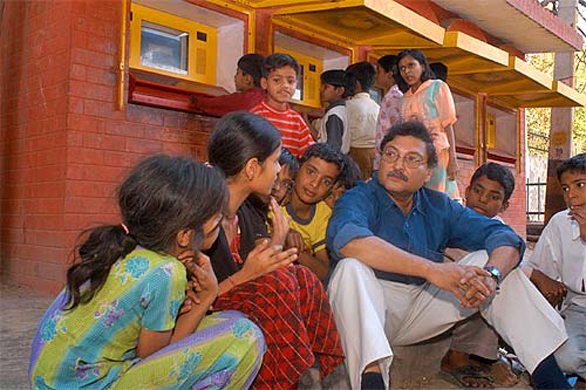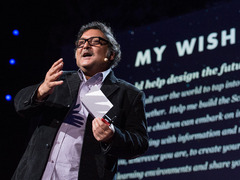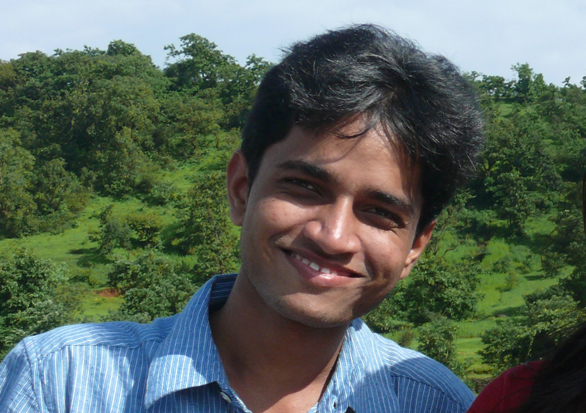
Sugata Mitra carved a hole in a wall in a New Delhi slum—about 3 feet high—and placed a computer in it. When kids asked what it was, he said, “I don’t know,” and walked away. Photo: courtesy of Sugata Mitra.
After his 6-year-old son taught himself to use a computer, 2013 TED Prize winner Sugata Mitra wanted to test the idea that kids can learn on their own, by discovery rather than formal training. So Mitra and his colleagues dug a hole in the wall near a slum in New Delhi, set up an Internet-connected computer there, and abandoned it in 1999. They also set up a hidden camera.
 Sugata Mitra: Build a School in the Cloud
Before long, children from the community figured out how to search for information online. They began learning English and other subjects, and started teaching each other. Consequently, Mitra’s “Hole in the Wall” experiment catalyzed his pursuit to advance child-driven learning for thousands of kids around the world.
Sugata Mitra: Build a School in the Cloud
Before long, children from the community figured out how to search for information online. They began learning English and other subjects, and started teaching each other. Consequently, Mitra’s “Hole in the Wall” experiment catalyzed his pursuit to advance child-driven learning for thousands of kids around the world.
In his talk from TED2013, Mitra describes repeating the “Hole in the Wall” experiment 300 miles away. He installed a mysterious computer on the side of a road where such machinery was even less familiar than in New Delhi.
12-year-old Arun Chavan was one of the kids who found himself drawn to that computer in Shirgaon, a coastal village in India. Over the next few months, he taught himself to use it. And now, more than a decade later, he lives in the United States and studies at Yale University.
We connected with Chavan to discover how the “Hole in the Wall” impacted his life. Here’s what he’s up to today:
How old are you?
I am 23 now.
And you’re at Yale. What inspires you about your field of study?
I am doing a PhD in Evolutionary Biology. I’m just amazed by the stunning diversity of organisms around us. The excitement of digging into the past to discover how it arose is what keeps me going.
What were your first thoughts when the street-side computer appeared in your community?
I was a kid then, studying in the sixth grade. I had never handled a computer before. I thought it was great to have those computers lying around to play with. I don’t remember being afraid to use them. I think we figured out soon enough that restarting the computer fixes almost every problem!
What was your favorite thing about participating in the “Hole in Wall” program?
I would say mainly three things: First, that there was nobody telling us what to do and not to do. Second, that it wasn’t the same as having a computer to yourself. We learned things as a group. We learned everything empirically, and taught each other what we found. And third, that the computers in the “Hole in the Wall” were connected to the Internet. It was amazing to be able to Google anything, or to chat with my sister who was studying in a different city.
How did your family feel about your participation? Did it affect their lives in any way?
My parents were as excited as I was. A few years later when we got ourselves a computer, the only thing I taught my father to do was to switch it on. In his 40s, he taught himself how to use it, and now he regularly blogs to share his paintings and writings.
Are you still in contact with the kids you studied with using the “Hole in the Wall” computer?
Unfortunately, I am not in contact with many of my friends from that time. Some of us went to different cities to attend college after high school. Most of those who stayed back attended vocational training programs and are working now.
Now that you’re a PhD student, are you teaching? If so, did your experience with the “Hole in the Wall” impact the way you instruct and connect with students?
Only recently have I started teaching. In the discussion sessions I lead, I tend not to intervene unless it is necessary, and I try to let the students understand things from their own discussion and ideas. I don’t know if I borrowed this approach from “Hole in the Wall,” but I find it similar.
What is the most important thing you learned from the “Hole in the Wall” experience?
Sugata Mitra’s “Hole if the Wall” idea is quite radical, I think. But it’s too important to be ignored. I like how he dares to imagine (and also hopes for) a completely different future of education than most of us do.
Along with the “Hole in the Wall,” many other things — interactions with certain people, books, and parents — have impacted my way of thinking. It’s really hard to tease apart what I have learned from the “Hole in the Wall.” I think that you can learn anything if you really want to — this could possibly be a “Hole in the Wall” effect.
What does curiosity mean to you?
A driving force to explore something new, I guess! Curiosity is also exciting for me.
If you could give a TED Talk, what would it be about?
My father writes and directs plays. As a kid, I acted in many of them. These plays have significantly influenced my thinking and have greatly contributed to who I am. If I had to give a TED talk, it would probably be about that experience.

Arun Chavan is now studying for a PhD at Yale. Photo: courtesy of Arun Chavan.
To learn more about the Hole in the Wall, read Sugata Mitra’s TED Book, Beyond the Hole in the Wall: Discover the Power of Self-Organized Learning. And for more on how to inspire self-organized learning wherever you may be, download this toolkit »
Comments (14)
Pingback: Mitra Myths – Slum children with no English? – Teachwell
Pingback: Mitra Myths – Slum Children with no English? | Teachwell
Pingback: Incredible Journey of Arun Chavan: From Sugata Mitra’s ‘The Hole in the Wall’ to Yale University
Pingback: Who Needs a Teacher? « pleasureinlearning
Pingback: From the Hole in the Wall to Yale: A Q&A with Arun Chavan | TED Blog | APRENDIENDO CONECTAD@S
Pingback: Protesters rally to save part of Berlin Wall | eJumo
Pingback: Kyle Busch Slams Opponent Into Wall At Finish Line To Win Nationwide Race - Filmspot.lv
Pingback: Prava ideja je lahko seme velike spremembe. Kakšno vlogo ima pri tem tehnologija? | Smart AD blog
Pingback: Inspiring post for the day: | embryoconcepts
Pingback: Wizmo Blog » Blog Archive » From the Hole in the Wall to Yale: A Q&A with Arun Chavan